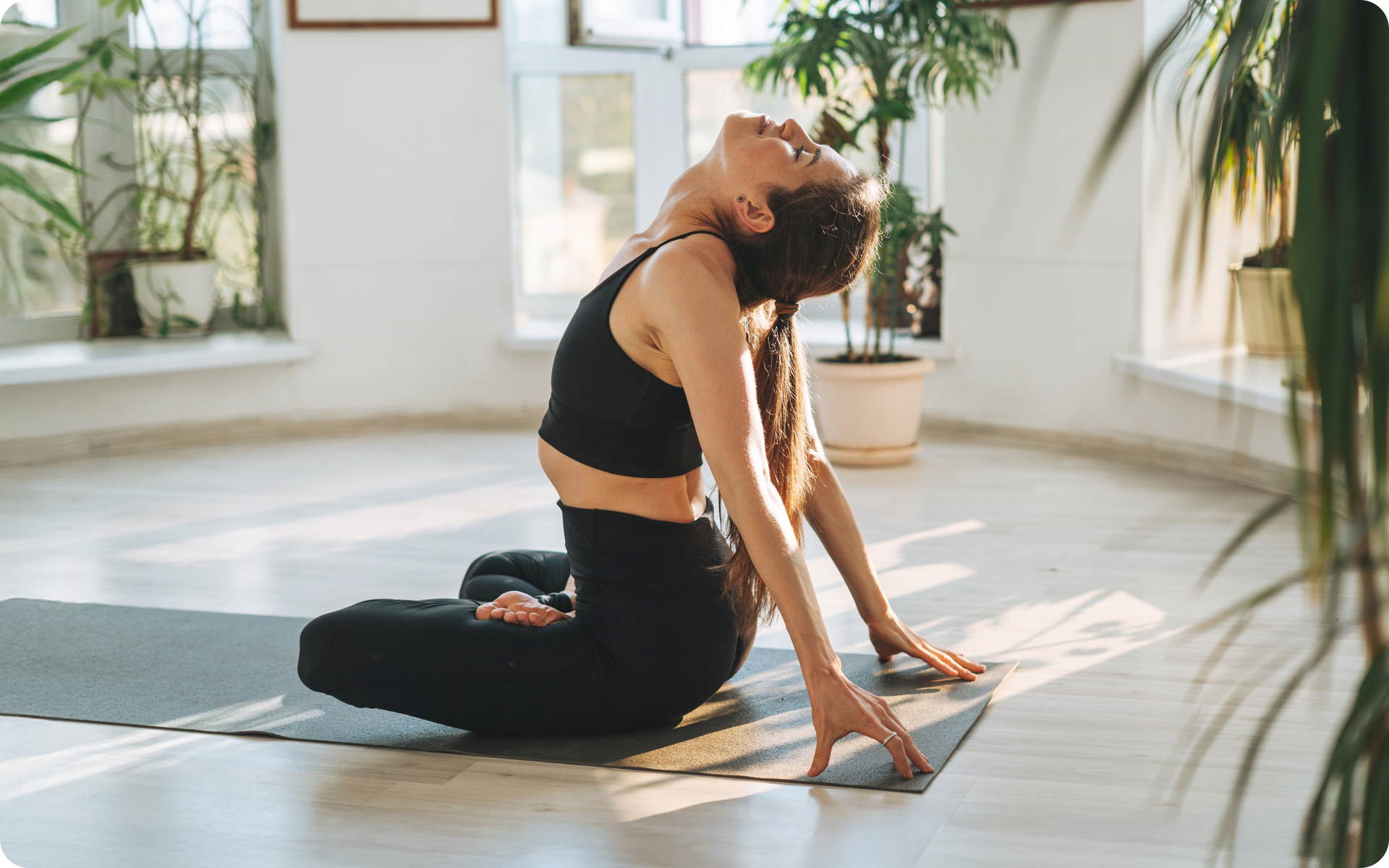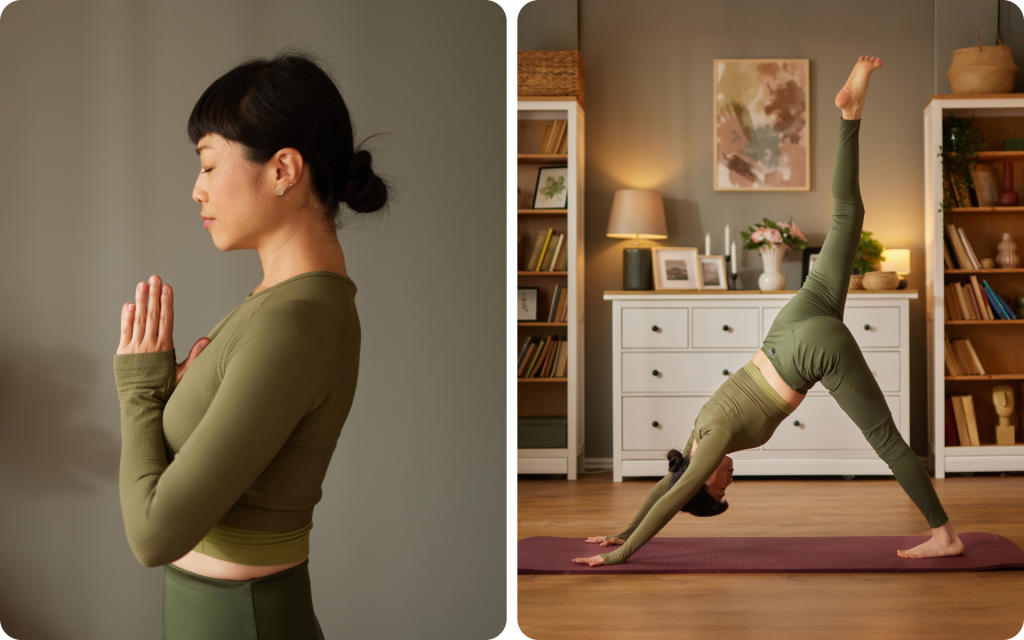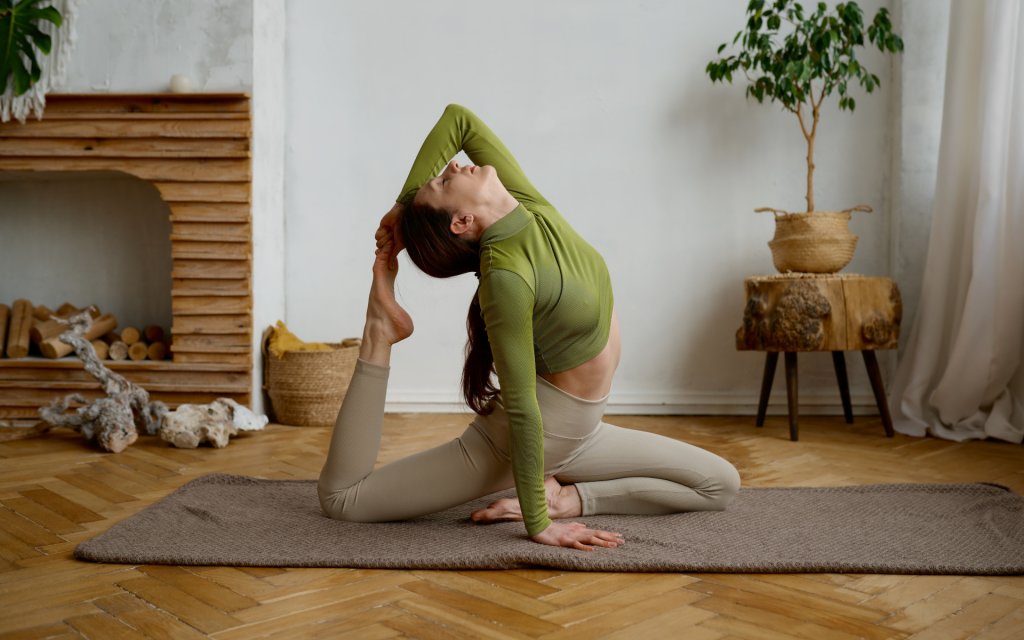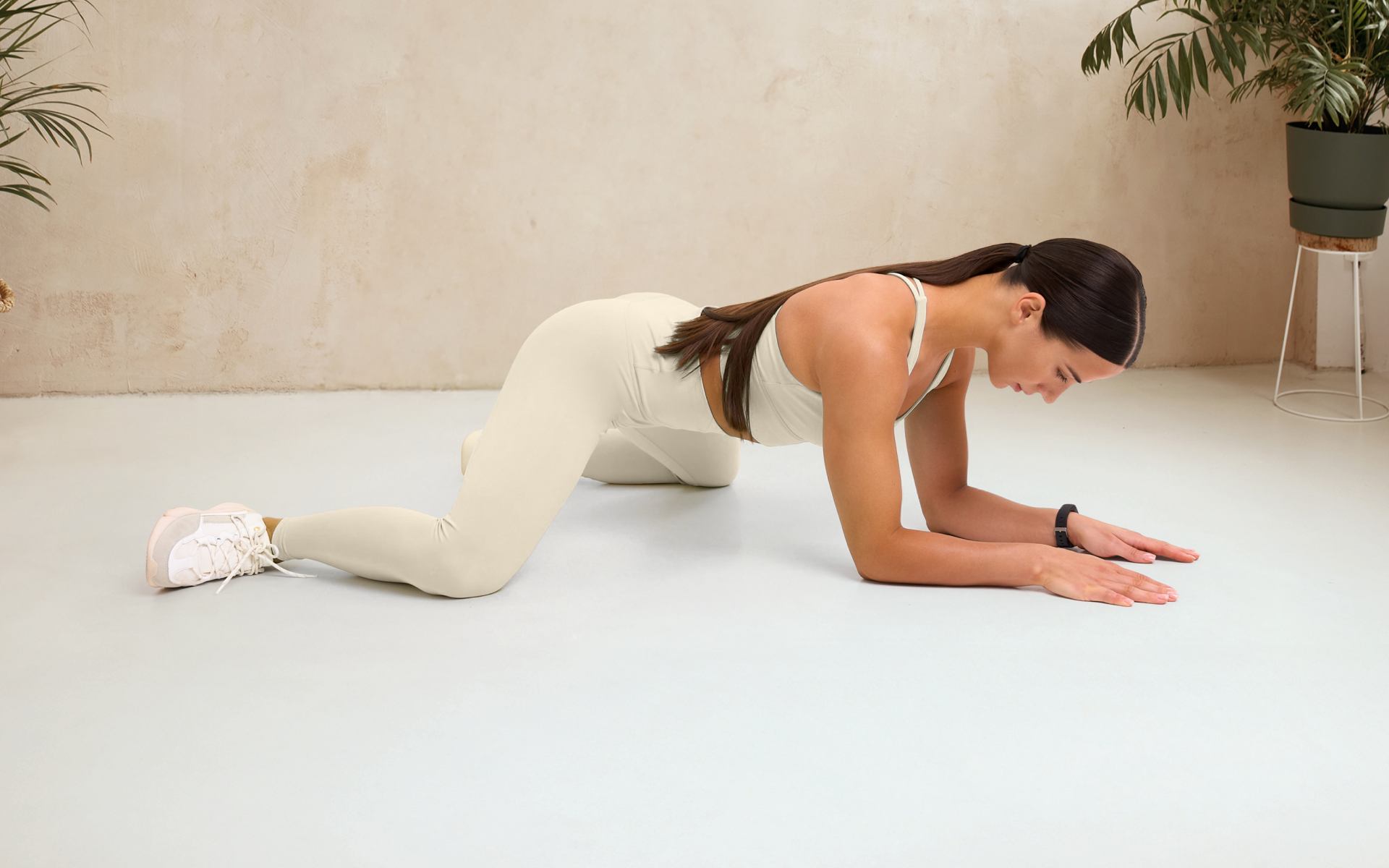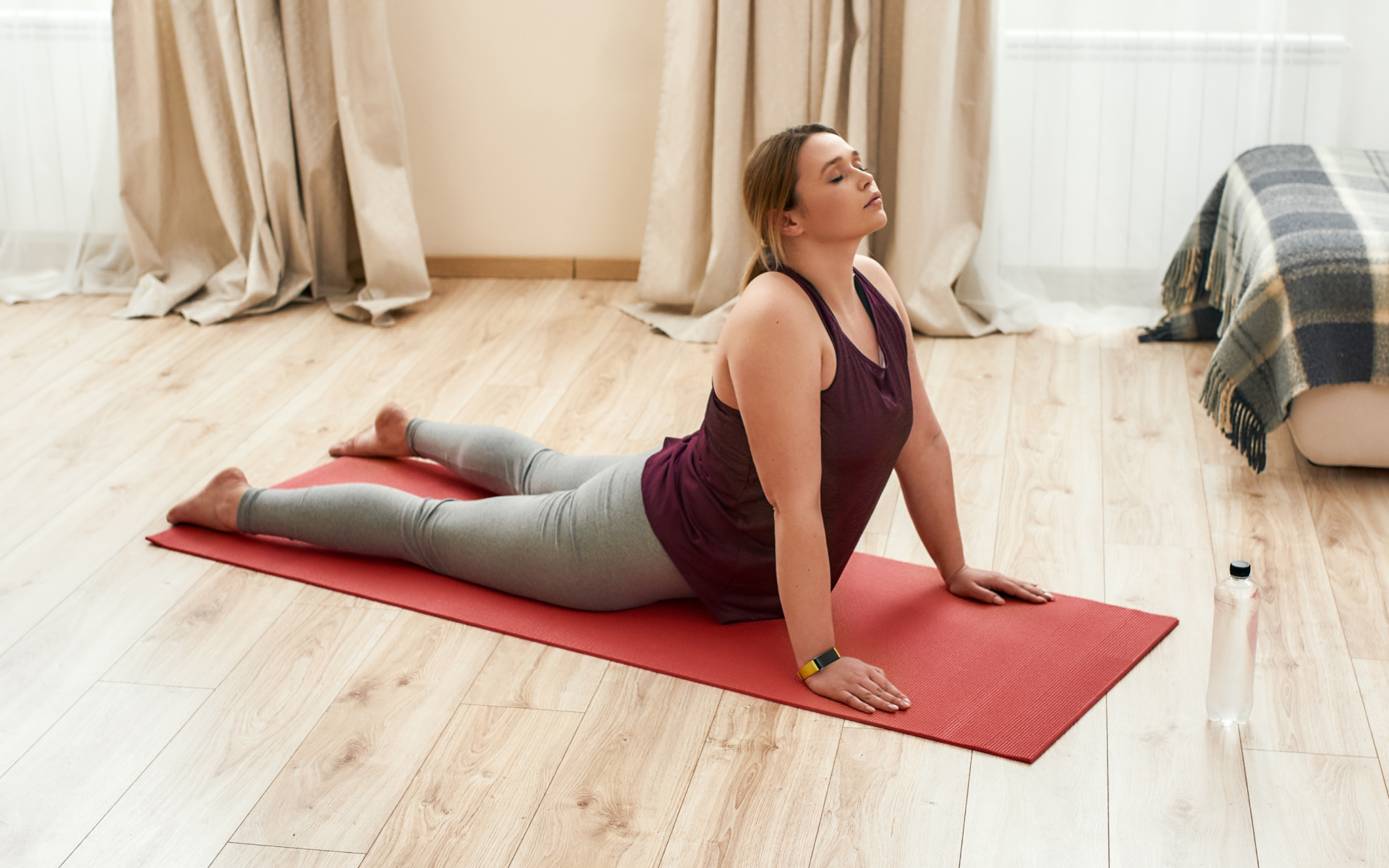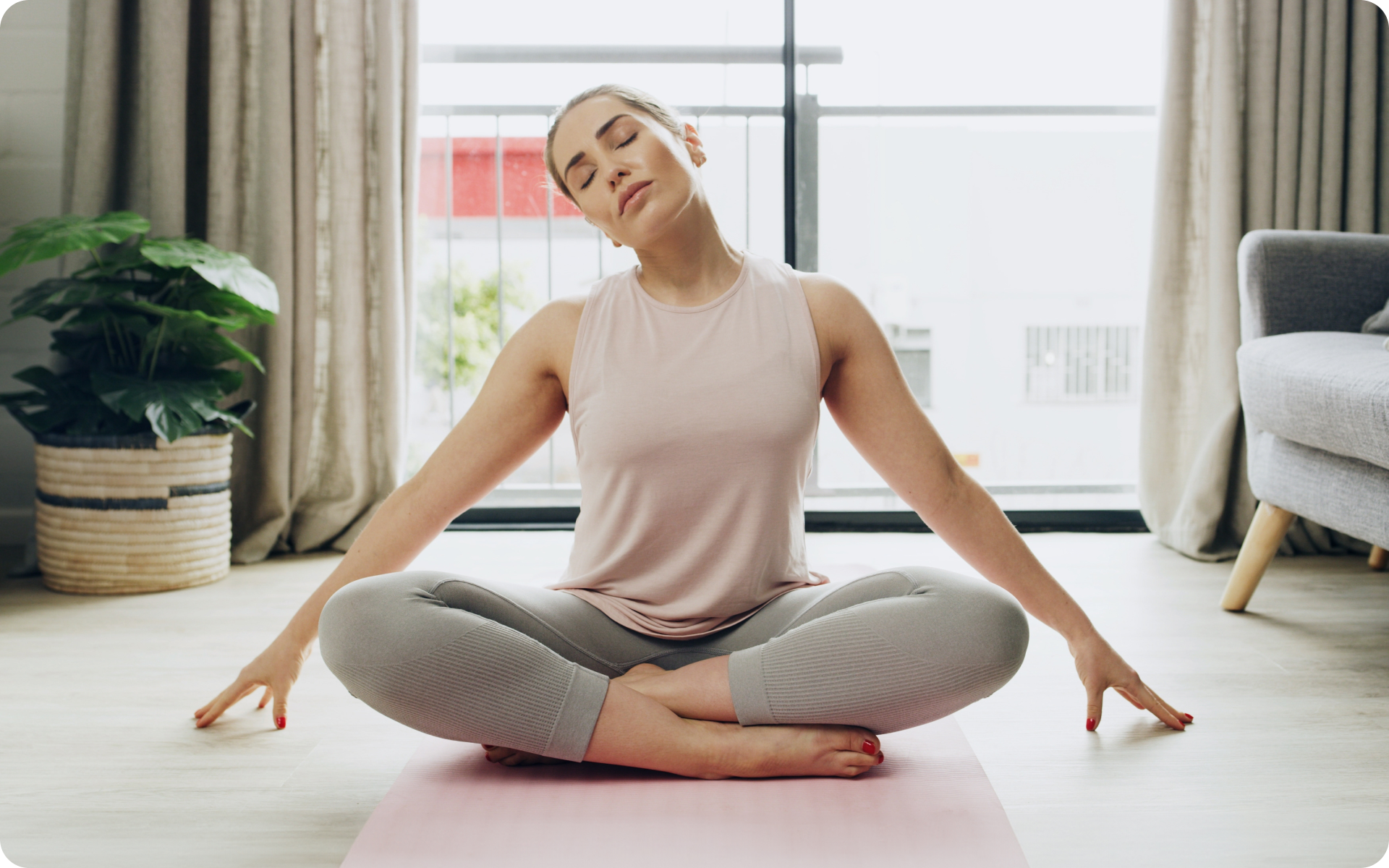Somatic yoga goes beyond holding poses and flowing seamlessly through sequences. It’s a practice where you pair intentional, exploratory movements with an acute awareness of what’s happening within your body. Each pose or transition is a chance to feel, adjust, and understand how your body communicates with you.
Somatic yoga isn’t about how deep you can stretch or how strong a pose appears. Instead, it’s about fostering curiosity, creating ease, and rewiring habitual patterns of tension. It offers a way to move in harmony with your body, not against it.
In this post, we’ll unpack the defining traits of somatic yoga and explore some exercises that can help you experience this practice firsthand.
What Is an Example of a Somatic Exercise in Yoga?
One of the simplest ways to understand somatic movement in yoga is through cat-cow pose. This traditional yoga exercise gently warms up your spine and helps improve your overall posture and flexibility. But when approached somatically, it becomes a practice of deep internal awareness.
To perform this exercise:
- Start on all fours in a tabletop position. Align your wrists under your shoulders and your knees under your hips.
- On an inhale, drop your belly, lift your chest, and tilt your tailbone upward into a backbend (cow pose). Allow your head to follow by gazing upward.
- On an exhale, round your spine upward, pressing through your hands and knees to curve your back like a dome (cat pose). Tuck your chin toward your chest and draw your belly up.
- Continue flowing between these movements in sync with your breathing for several cycles.
This traditional approach emphasizes alignment and a smooth rhythm with breath. Now let’s see how somatic principles transform this into a more mindful, exploratory experience.
Cat-Cow as a Somatic Movement:
1. Focus
To bring a somatic layer to this practice, start by closing your eyes if you feel comfortable doing so. This removes visual distractions and strengthens your mind-body connection. Tune into each joint that is involved in the movement, from your hands pressing into the ground to the tilt of your pelvis. Pay attention to your breathing, not just its rhythm, but how it feels in your chest, belly, or back as you inhale and exhale.
Intention: Focusing inward develops proprioception, your ability to sense your body’s position and movement in space.
2. Exploration
Rather than strictly following the suggested pattern (inhale for cow, exhale for cat), give yourself permission to explore. Maybe you isolate one area of your spine at a time, such as moving vertebra by vertebra. Ask yourself, “What feels tight? Where do I feel lightness or stiffness?”
Intention: Exploration here allows you to uncover habitual tension patterns and shift them. For example, you may find that your lower back overcompensates for stiffness in your hips, a revelation that can reshape how you approach other movements.
3. Slow Execution
Deliberately slow the transitions between cat and cow. Feel every vertebra move as your spine arches and rounds. Pause midway through each motion to notice the engagement or resistance of your muscles. Instead of rushing through the sequence, give your nervous system time to process and register the movements.
Intention: Slowing down engages the sensory-motor system, which enhances communication between your brain and body. Over time, this can help rewire inefficient movement patterns and build new pathways for ease and control.
Read more: Somatic Flexibility Technique: Stretching to Release Tension and Build Self-Awareness
Do Somatic Exercises Actually Work?
While somatic exercises are still an emerging area of interest, several scientific principles suggest that they can be effective tools for improving movement quality and overall well-being. By working with your body’s neuromuscular system and encouraging mindful focus, these exercises offer a unique way to tap into how your body moves and responds.
- Somatic Exercises May Improve Muscle Memory
Muscle memory refers to your body’s ability to repeat a movement without conscious thought after repeated practice (1). Somatic exercises can help you refine this process by slowing movements down, giving your brain time to “relearn” efficient pathways.
For example, if certain muscles are habitually tense or imbalanced, somatic movements allow you to identify these inefficiencies. With consistent practice, you can retrain your motor patterns for smoother, more controlled movement.
When it comes to weight loss, progress is made by inches, not miles, so it’s much harder to track and a lot easier to give up. The BetterMe: Health Coaching app is your personal trainer, nutritionist, and support system all in one. Start using our app to stay on track and hold yourself accountable!
- Somatic Exercises Can Enhance the Mind-Body Connection
One of the core principles of somatic exercise is mindfulness, or bringing focused attention to your internal sensations. This is where the mind-body connection becomes significant (2).
By noticing the smallest shifts in tension or release during movement, you train your brain to better interpret signals from your body. Over time, this enhanced awareness can help you become more in tune with your physical needs, detect discomfort early, and respond to stress or injury more effectively.
- Somatic Exercises Support Neuromuscular Flexibility
Your neuromuscular system governs the communication between your brain, nerves, and muscles (3). Somatic exercises focus on resolving outdated or dysfunctional movement patterns that are stored in your system.
For example, habitual slouching may leave certain muscles overworked while others grow weak. Somatic work gives you a chance to reset these patterns, restoring balance. By slowing movements and exploring your range of motion, you encourage the nervous system to release chronic tension and recalibrate.
- Somatic Exercises May Reduce Stress
Somatic exercises often involve slower, intentional movements paired with deep breathing. This activates the parasympathetic nervous system, sometimes referred to as the “rest and digest” mode (4).
When this system is active, your body shifts away from chronic stress responses, such as muscle tightness or shallow breathing. Over time, this practice may help you manage stress more effectively and feel a greater sense of physical ease.
- Somatic Exercises Encourage Sustainable Movement Habits
Building internal awareness allows you to move with more purpose and care. This means you’re less likely to rely on compensation patterns that could lead to injury or strain.
For example, learning to feel the alignment of your hips or shoulders during exercise may help prevent joint stress. When movement starts to feel good and natural, you’re more likely to stick with it. This can lead to longer-term benefits that support sustainable health.
Do Somatic Exercises Really Release Trauma?
The idea that somatic exercises can help release trauma is rooted in how the body stores stress and memories (5). Trauma isn’t only a mental experience, it often leaves physical imprints on the body, showing up as chronic tension, restricted movement, or heightened sensitivity (6).
Somatic exercises aim to address these physical patterns through deep body awareness and gentle, mindful movement.
The Theory
Trauma can disrupt the natural connection between your brain and body, leading to “frozen” responses in your muscles and posture. Somatic practices encourage exploring these areas with curiosity instead of avoidance. By bringing attention to how your body feels, you may start to notice where you hold tightness or discomfort, creating space for release (5, 7).
Body awareness tools, such as scanning your body for sensations or moving slowly through a range of motion, are often used in somatic therapy. These exercises focus on fostering a sense of safety and control, which is key when working with trauma (8). Over time, this approach may help “reset” the nervous system, guiding it away from a constant state of hypervigilance.
BetterMe: Health Coaching app helps you achieve your body goals with ease and efficiency by helping to choose proper meal plans and effective workouts. Start using our app and you will see good results in a short time.
The Limitations
It’s important to note that somatic exercises alone aren’t a standalone treatment for trauma. While they may complement therapy, more research is needed to understand how and why they could work. Trauma is complex, and individual results can vary widely. Maintaining a regular somatic exercise practice while working with a psychologist supports trauma recovery from both a mental and physical perspective.
A Thoughtful Approach
For someone who is interested in trying somatic exercises, the focus should be less on “releasing trauma” and more on cultivating awareness, comfort, and a harmonious relationship with movement. These exercises thrive on patience and mindfulness, offering a safe space to reconnect with your body one small step at a time.
Should You Do Somatic Exercises Every Day?
As somatic exercises are designed to be restorative, it can be safe to do them every day. However, it’s essential to listen to your body. Some days may call for shorter sessions or less challenging movements.
Consider:
- Checking in with your body before you start a somatic exercise session. How do you feel physically and emotionally? Are there any areas of tension or discomfort?
- Adapting the exercises based on how you’re feeling that day. You can modify the movements to be gentler or more intense, depending on what your body needs.
- Practicing self-care and taking breaks as needed during the session.
- Consulting a somatic practitioner or physical therapist if you have any specific concerns or injuries.
How Do I Start Somatic Exercise?
Starting somatic exercise can feel like learning a new language for your body. It’s less about performing with a goal in mind and more about tuning into how your body feels.
1. Find a Quiet Space
Choose a calm, distraction-free area where you feel comfortable. A quiet environment will help you relax and focus on your movements without interruptions. Some people may prefer to have calming music without lyrics playing.
2. Get Comfortable
Wear loose, comfortable clothing that won’t restrict your movements. You may practice on a yoga mat or a soft carpeted area to give your body support.
3. Focus on Your Internal Sensations
Shift your attention inward and notice how your body feels before you even start moving. Focus on the sensations in your muscles, joints, and overall posture.
Focusing inward can be difficult and even scary at first. Give yourself grace as you attempt this.
4. Close Your Eyes
Removing visual distractions helps you fully concentrate on what you feel in your body rather than how you look. Closing your eyes can enhance this inward focus. You can keep your eyes open if it feels more comfortable.
5. Start with Slow, Gentle Movements
Somatic exercises should be done slowly and mindfully. Start with simple movements, and move at a pace where you can explore how each motion feels. Slower movements allow your nervous system to retrain and develop new muscle memory.
6. Focus on the Process, Not the Outcome
Don’t worry about achieving a specific pose or reaching a goal. Somatic exercise is about exploration. Each movement should be a fresh experience where you observe how your body feels in the present moment.
7. Be Patient
Learning to move in new ways takes time. Approach the process with curiosity rather than rushing. With regular practice, your nervous system can adapt, which can lead to improved movement patterns and tension release.
8. Commit to Consistency
Rather than pushing for perfection, focus on practicing daily or regularly. Even a few minutes a day can make a big difference over time as your body learns and adapts.
9. Stay Open to Exploration
Every session may feel different because your body holds patterns unique to each day. Tune into these changes and allow your movements to adjust naturally.
By following these steps, you’ll nurture greater awareness of your body, reduce tension, and improve your overall physical and mental well-being. Remember, somatic exercise is a personal and evolving practice, so you should take your time and listen closely to what your body needs.
Read more: Is Somatic Therapy Evidence-Based? What to Know Before Getting Started
What Time of Day Is Best to Do Somatic Yoga?
The best time to practice somatic yoga depends on your goals, lifestyle, and personal rhythm. There’s no single “right” time, as this mindful approach to movement can fit seamlessly into different parts of your day. Here’s how timing can shape your experience:
- Morning Practice for Energy and Focus
Starting your day with somatic yoga can be invigorating. Gentle movements and focused breathing help wake up your body, release stiffness, and set a grounded intent for the day. It’s an excellent option if you want to boost focus or cultivate mental clarity before heading into tasks or work. Even 10-15 minutes of practice can shift how you approach your morning.
- Afternoon Practice for a Reset
Afternoons often come with a dip in energy or motivation. Practicing somatic yoga during this time can act as a reset, breaking up long periods of sitting or physical strain. Tuning into your body can help you release built-up tension, regain focus, and move into the second half of the day feeling refreshed.
- Evening Practice for Relaxation
Somatic yoga is designed to calm the nervous system, which makes it an ideal evening activity. Practicing before bed can help you release the day’s stress and prepare for restorative sleep. Slow movements paired with deep breathing encourage relaxation and ease, which makes it perfect for unwinding (9).
- Experiment to Find Your Ideal Time
As somatic yoga emphasizes listening to your body, the timing should be aligned with when you feel most receptive. Some people enjoy the energizing effects of a morning session, while others prefer to unwind with it before bed. Experiment with different times of day to see what feels most natural for you and supports your goals.
Is Somatic Yoga the Same as Pilates?
Somatic yoga and Pilates aren’t the same. While they share some overlapping benefits, such as improving body awareness and movement quality, they differ significantly in terms of purpose, execution, and philosophy.
Somatic yoga focuses on internal awareness and mindful movement. It’s less about achieving an ideal pose and more about exploring how your body feels as you move (10).
This practice emphasizes nervous system regulation, using slow, controlled movements to release tension and establish a deeper connection between your mind and body. The goal isn’t just physical flexibility, it’s also a greater awareness of your movement patterns and how they impact overall well-being.
On the other hand, Pilates is a more structured exercise system. It was originally designed to improve core strength, posture, and alignment (11).
While it also incorporates mindful movement, Pilates exercises typically follow a specific sequence, often involving repetitions with precise technique. The primary aim is physical conditioning, particularly strengthening the core muscles that support the spine and improving overall stability (12).
Yes, you can practice somatic therapy on yourself by engaging in mindful, intentional movements that are focused on internal sensations. Techniques such as somatic yoga, breathing exercises, and gentle self-pacing allow you to explore and release tension in your body. However, for deeper issues, guidance from a trained practitioner may be more effective. No, somatic yoga isn’t just stretching. While it may involve movements that resemble stretching, the focus is on internal awareness, releasing patterns of tension, and retraining the nervous system rather than achieving flexibility or specific poses. Yes, somatic yoga is a legitimate practice. It combines mindfulness with gentle movements to promote nervous system regulation, improve body awareness, and release chronic tension. It’s recognized for its therapeutic benefits in both physical and mental well-being. Yes, you can practice somatic yoga in a chair. Chair-based somatic movements are a great option for individuals with mobility challenges or those who are looking for a more accessible approach. The goal remains the same – to focus on internal sensations and conscious, gentle movement.Frequently Asked Questions
Can I do somatic therapy on myself?
Is somatic yoga just stretching?
Is somatic yoga a real thing?
Can you do somatic yoga in a chair?
The Bottom Line
Somatic yoga exercises are mindful practices that emphasize gentle, intentional movements, helping enhance internal awareness and release tension that is held in the body. Unlike traditional yoga or stretching routines, somatic yoga is focused on the process of reconnecting with your nervous system to create healthier movement patterns.
DISCLAIMER:
This article is intended for general informational purposes only and does not serve to address individual circumstances. It is not a substitute for professional advice or help and should not be relied on for making any kind of decision-making. Any action taken as a direct or indirect result of the information in this article is entirely at your own risk and is your sole responsibility.
BetterMe, its content staff, and its medical advisors accept no responsibility for inaccuracies, errors, misstatements, inconsistencies, or omissions and specifically disclaim any liability, loss or risk, personal, professional or otherwise, which may be incurred as a consequence, directly or indirectly, of the use and/or application of any content.
You should always seek the advice of your physician or other qualified health provider with any questions you may have regarding a medical condition or your specific situation. Never disregard professional medical advice or delay seeking it because of BetterMe content. If you suspect or think you may have a medical emergency, call your doctor.
SOURCES:
- Muscle Memory and the Somaesthetic Pathologies of Everyday Life (2011, researchgate.net)
- Mindfulness, Interoception, and the Body: A Contemporary Perspective (2019, ncbi.nlm.nih.gov)
- Anatomy, Central Nervous System (2023, ncbi.nlm.nih.gov)
- Somatic Exercise: A Guide to Restoring Body Awareness (2024, news-medical.net)
- Somatic experiencing – effectiveness and key factors of a body-oriented trauma therapy: a scoping literature review (2021, ncbi.nlm.nih.gov)
- Understanding the Impact of Trauma – Trauma-Informed Care in Behavioral Health Services (2014, ncbi.nlm.nih.gov)
- Trauma-related cultural concepts of distress: A systematic review of qualitative literature from the middle east and North Africa, and Sub-Saharan Africa (2025, sciencedirect.com)
- Somatic experiencing: using interoception and proprioception as core elements of trauma therapy (2015, ncbi.nlm.nih.gov)
- Bringing therapy to life: Exploring the benefits of yoga and somatic mindfulness in psychotherapy (2023, researchgate.net)
- Somatic Yoga: Definition, Core Principles, and Techniques (2024, yogabasics.com)
- Pilates: how does it work and who needs it? (2011, ncbi.nlm.nih.gov)
- Pilates, Mindfulness and Somatic Education (2013, ncbi.nlm.nih.gov)
